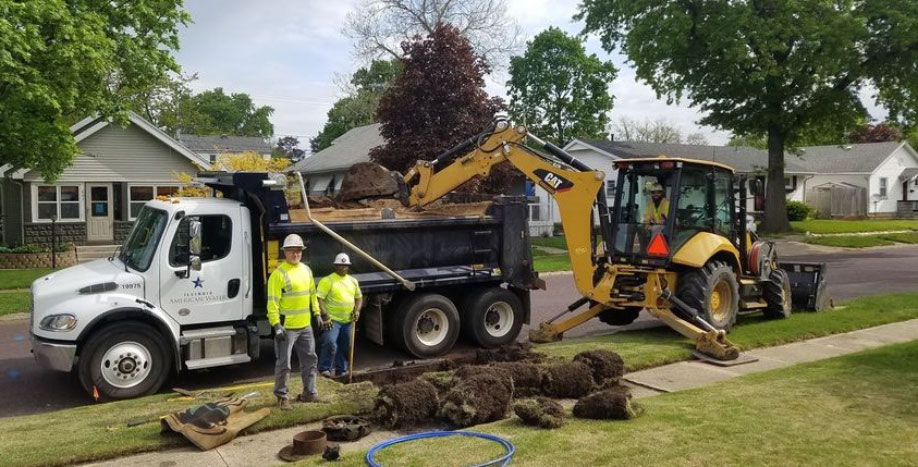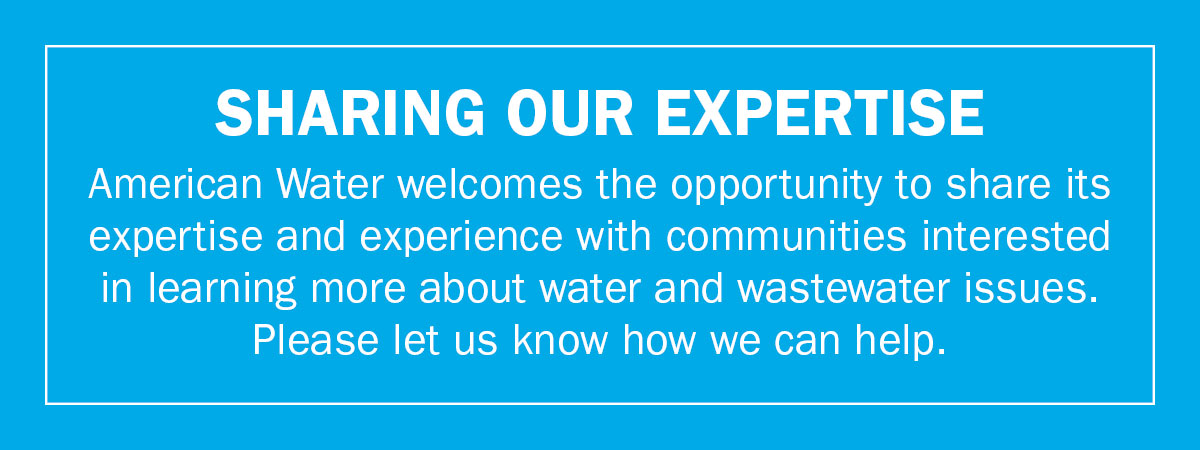Welcome to the Pipeline!
Welcome to the latest edition of American Water's the Pipeline, a quarterly resource for all things water. We see this as one more way to stay connected.
A Note from Val Armstrong

Resiliency: American Water Keeps Life Flowing
Flooding in the Midwest, droughts and fires in the West and increasingly intense storms throughout the East and across the U.S. have created operational challenges for many utilities. American Water’s employees and systems have remained resilient in the face of these extreme weather events, as well as cyber and physical attacks directed at the company’s infrastructure. These challenges seem to be increasing in their frequency and have the potential to place strain on our critical infrastructure and impact the lives of all water customers.
Proactive planning and having a strong resiliency plan is an imperative for utilities to address these events. Resiliency as defined by Merriam-Webster is "an ability to recover from or adjust easily to adversity or change." The industry recognizes that successful responses to a changing operational landscape require an ongoing commitment of resources and planning, collaboration with regulators and stakeholders, as well as communications with customers. As the largest and most geographically diverse water company in the country, American Water has extensive experience in confronting the challenges to the industry.

Our Customers and Employees
Our employees play a key role in the company’s resiliency strategy. By fostering an inclusive and diverse workforce, we are able to draw on a wealth of knowledge, industry expertise, experience and ideas as we develop and deploy new strategies to meet ever-changing threats. We are proud to be included in the 2022 Bloomberg Gender-Equality Index (GEI) for the fourth consecutive year and recognized for our longstanding commitment to gender equality throughout our company. We are equally as honored for being named on Corporate Knights’ 18th annual Global 100 list of the World’s Most Sustainable Corporations for the third year in a row. We attribute these recognitions to the great work of our committed employees.
These and other elements of American Water’s resiliency strategy are discussed in more detail below.
Sincerely, 

Investment in Resiliency of the System and Customers
A significant portion of our nation’s water infrastructure is nearing 100 years of age, and investment is paramount in order to maintain and enhance the resiliency of these water systems. The American Society of Civil Engineers (ASCE) issued a report in 2021 that concluded that “the system is aging and underfunded.” The nation’s infrastructure was graded a D+. Drinking water and wastewater was graded a C- and D+, respectively. The Value of Water and ASCE’s 2020 economic study, “The Economic Benefits of Investing in Water Infrastructure: How a Failure to Act Would Affect the U.S. Economic Recovery,” found that the annual drinking water and wastewater investment gap will grow to $434 billion by 2029.
American Water’s infrastructure investments increase the ability of our systems to withstand extreme weather events, physical and cyber- attacks and the next potential threat that lies just over the horizon. It also enhances the performance of our systems during and after natural and man-made events and aims to minimize impact to the lives of our customers.
Below are several core aspects of American Water’s resiliency strategy:
- Investment. American Water plans to spend 10-12% of its total projected capital investment on resiliency over the next five years. This translates to approximately $1.15 billion for the renewal and improvement of the company’s assets.
- Monitoring The company utilizes the Utility Resiliency Index (“URI”), a uniform water system resiliency metric, to track enhancements around the company’s ability to prepare for and respond to events that impact operations. By 2030, the company intends to increase its URI weighted average by 10% from 2020 baseline.
- Asset-Hardening. American Water builds flood walls and flood-proof assets beyond anticipated flood levels and deploys emergency power systems to address electric service interruptions. American Water also works to avoid cascading failures across the utility space by implementing back-up electrical systems. For instance, the company recently completed a $15 million emergency power generation system at its Raritan Millstone Water Treatment Facility designed to keep the plant operational in the event of a power failure.
- Disaster Preparedness. American Water regularly engages with state and federal policymakers, regulators, and other stakeholders to plan for resiliency challenges and so-called “Black Sky Days” – long-duration disruptions that can stem from extreme weather events, natural disasters or man-made attacks on critical infrastructure.
 Cybersecurity Measures. Water utilities have been the target of cyber-attacks, which could impact service and threaten the health and safety of customers. In February of last year, a small municipal water system in Oldsmar, Florida was subject to a cyberattack. Hackers infiltrated the municipal water utility’s computer system and gained access to the system that automates the type of chemicals to be added during the treatment process. Luckily, no harm occurred as an employee discovered the issue. In June of 2021, a San Francisco water system suffered a cyberattack where the hacker, using the username and password of a former employee, remotely accessed the plant’s computers and deleted important programs. Water is not only an essential service, but it is the only utility that provides a service that is ingested by customers. The White House recognizes the importance water plays in society. Last year, President Biden invited our CEO, Walter Lynch, and other industry leaders to join him and members of his cabinet in a resiliency conversation
Cybersecurity Measures. Water utilities have been the target of cyber-attacks, which could impact service and threaten the health and safety of customers. In February of last year, a small municipal water system in Oldsmar, Florida was subject to a cyberattack. Hackers infiltrated the municipal water utility’s computer system and gained access to the system that automates the type of chemicals to be added during the treatment process. Luckily, no harm occurred as an employee discovered the issue. In June of 2021, a San Francisco water system suffered a cyberattack where the hacker, using the username and password of a former employee, remotely accessed the plant’s computers and deleted important programs. Water is not only an essential service, but it is the only utility that provides a service that is ingested by customers. The White House recognizes the importance water plays in society. Last year, President Biden invited our CEO, Walter Lynch, and other industry leaders to join him and members of his cabinet in a resiliency conversation
State Action to Address Water Resiliency
Several states have passed laws aimed at bolstering the cyber and physical security of water systems. New Jersey was one of the first states to design such a law. New Jersey’s Water Quality Accountability Act sets forth a number of requirements that water systems with 500 or more connections must meet to continue the consistent provision of water services across the state. Included among these criteria is the requirement to develop a cybersecurity plan and conduct regular risk assessments in order to be aware of any cyber threats and vulnerabilities. This type of legislation directly benefits customers and communities as they hold all water providers to the same standards. Indiana and Missouri passed similar legislation in 2018 and 2020, respectively.
We applaud these efforts and stand ready to work with legislators and regulators across our footprint to develop similar frameworks so that all consumers are protected and served by resilient water systems.
Spotlight: Interview with Suzanne Chiavari Director, Engineering Treatment & Asset Resiliency |
|||
|
Utility Preparedness
The utility industry continues to enhance the resilience of its system by anticipating and identifying potential disruptions through the deployment of advanced technologies. As Suzanne Chiavari shared, the company also focuses on the physical hardening of our infrastructure in order to have assets that can rapidly recover from such events. Our investments also extend to providing training for employees that maintain our daily operations, employing new and enhanced measures to keep our employees safe, as well as the customers we serve.
Future editions of the Pipeline newsletter will highlight initiatives aimed at informing and educating our customers on the availability of customer-centric programs. At American Water, we keep life flowing.
Resources
American Water wants to be a resource of information for you. Through active outreach and engagement with a variety of stakeholders, American Water has taken part in a great exchange of ideas, issues and insights about challenges and opportunities impacting the water and wastewater industry. Please do not hesitate to reach out to us on any water or wastewater topic. Here are just a few examples of resources that provide background on the topics we covered:
- White House Memo on Cybersecurity and the Private Sector – White House memo that urges the private sector to implement best practices identified in President Biden’s Executive Order.
- Executive Order on Improving the Nation’s Cybersecurity – The Biden administration issued an Executive Order focused on strengthening the federal government’s response to cyber threats. The EO is however limited to the federal government and contractors.
- EPA Water & Wastewater Cybersecurity Brief for States – A brief published by the EPA to support states in response to cyberattacks on water utilities.
- NCSL Overview of Cybersecurity Legislation in 2021 – The NCSL has compiled a list of state legislative efforts on the cybersecurity front in 2021.
- EPA Announces Action Plan to Accelerate Cyber-Resilience for the Water Sector – A news release published by the EPA announcing its Industrial
We're here if you need us.
|
|||




